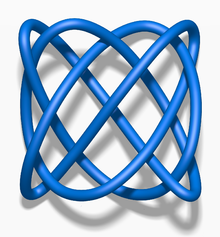Lissajous knot
In knot theory, a Lissajous knot is a knot defined by parametric equations of the form

where , , and are integers and the phase shifts , , and may be any real numbers.[1]
The projection of a Lissajous knot onto any of the three coordinate planes is a Lissajous curve, and many of the properties of these knots are closely related to properties of Lissajous curves.
Replacing the cosine function in the parametrization by a triangle wave transforms every Lissajous knot isotopically into a billiard curve inside a cube, the simplest case of so-called billiard knots. Billiard knots can also be studied in other domains, for instance in a cylinder[2] or in a (flat) solid torus (Lissajous-toric knot).
Form
Because a knot cannot be self-intersecting, the three integers must be pairwise relatively prime, and none of the quantities
may be an integer multiple of pi. Moreover, by making a substitution of the form , one may assume that any of the three phase shifts , , is equal to zero.
Examples
Here are some examples of Lissajous knots,[3] all of which have :
- 821 knot
There are infinitely many different Lissajous knots,[4] and other examples with 10 or fewer crossings include the 74 knot, the 815 knot, the 101 knot, the 1035 knot, the 1058 knot, and the composite knot 52* # 52,[1] as well as the 916 knot, 1076 knot, the 1099 knot, the 10122 knot, the 10144 knot, the granny knot, and the composite knot 52 # 52.[5] In addition, it is known that every twist knot with Arf invariant zero is a Lissajous knot.[6]
Symmetry
Lissajous knots are highly symmetric, though the type of symmetry depends on whether or not the numbers , , and are all odd.
Odd case
If , , and are all odd, then the point reflection across the origin is a symmetry of the Lissajous knot which preserves the knot orientation.
In general, a knot that has an orientation-preserving point reflection symmetry is known as strongly positive amphicheiral.[7] This is a fairly rare property: only seven prime knots with twelve or fewer crossings are strongly positive amphicheiral (1099, 10123, 12a427, 12a1019, 12a1105, 12a1202, 12n706).[8] Since this is so rare, ′most′ prime Lissajous knots lie in the even case.
Even case
If one of the frequencies (say ) is even, then the 180° rotation around the x-axis is a symmetry of the Lissajous knot. In general, a knot that has a symmetry of this type is called 2-periodic, so every even Lissajous knot must be 2-periodic.
Consequences

The symmetry of a Lissajous knot puts severe constraints on the Alexander polynomial. In the odd case, the Alexander polynomial of the Lissajous knot must be a perfect square.[9] In the even case, the Alexander polynomial must be a perfect square modulo 2.[10] In addition, the Arf invariant of a Lissajous knot must be zero. It follows that:
- The trefoil knot and figure-eight knot are not Lissajous.
- No torus knot can be Lissajous.
- No fibered 2-bridge knot can be Lissajous.
References
- ^ a b Bogle, M. G. V.; Hearst, J. E.; Jones, V. F. R.; Stoilov, L. (1994). "Lissajous knots". Journal of Knot Theory and Its Ramifications. 3 (2): 121–140. doi:10.1142/S0218216594000095.
- ^ Lamm, Christoph; Obermeyer, Daniel (1999). "Billiard knots in a cylinder". Journal of Knot Theory and Its Ramifications. 8 (3): 353–366. arXiv:math/9811006. Bibcode:1998math.....11006L. doi:10.1142/S0218216599000225. S2CID 17489206.
- ^ Cromwell, Peter R. (2004). Knots and links. Cambridge, UK: Cambridge University Press. p. 13. ISBN 978-0-521-54831-1.
- ^ Lamm, C. (1997). "There are infinitely many Lissajous knots". Manuscripta Mathematica. 93: 29–37. doi:10.1007/BF02677455. S2CID 123288245.
- ^ Boocher, Adam; Daigle, Jay; Hoste, Jim; Zheng, Wenjing (2007). "Sampling Lissajous and Fourier knots". arXiv:0707.4210 [math.GT].
- ^ Hoste, Jim; Zirbel, Laura (2006). "Lissajous knots and knots with Lissajous projections". arXiv:math.GT/0605632.
- ^ Przytycki, Jozef H. (2004). "Symmetric knots and billiard knots". In Stasiak, A.; Katrich, V.; Kauffman, L. (eds.). Ideal Knots. Series on Knots and Everything. Vol. 19. World Scientific. pp. 374–414. arXiv:math/0405151. Bibcode:2004math......5151P.
- ^ See Lamm, Christoph (2023). "Strongly positive amphicheiral knots with doubly symmetric diagrams". arXiv:2310.05106 [math.GT]. This article contains a complete list of prime strongly positive amphicheiral knots up to 16 crossings.
- ^ Hartley, R.; Kawauchi, A (1979). "Polynomials of amphicheiral knots". Mathematische Annalen. 243: 63–70. doi:10.1007/bf01420207. S2CID 120648664.
- ^ Murasugi, K. (1971). "On periodic knots". Commentarii Mathematici Helvetici. 46: 162–174. doi:10.1007/bf02566836. S2CID 120483606.



























